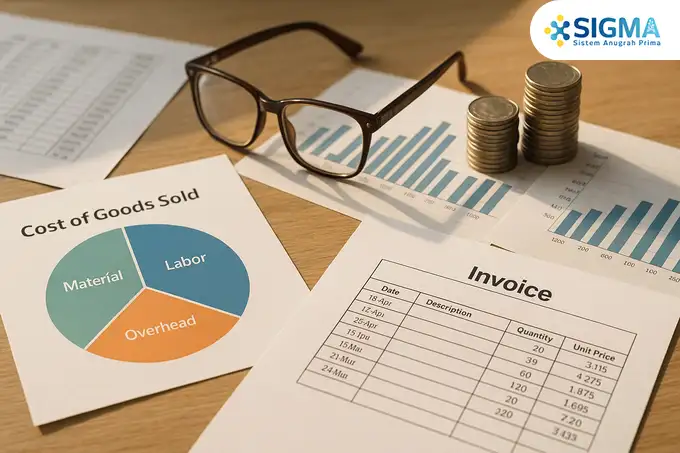Learn how to calculate Cost of Goods Sold (COGS) accurately and practically—from raw material costs, labor, to production overhead—specifically designed for beginners who want to avoid costly mistakes and ensure every product yields optimal profit.
Fellow entrepreneurs, have you ever experienced this? Your products seem to sell like hotcakes—every day, something gets sold—yet at the end of the month, your profits are nowhere to be found. In fact, you often have to dip into your own pockets just to restock.
If that sounds familiar, chances are you haven’t fully met the true culprit: the Cost of Goods Sold (COGS).
Many beginners mistakenly believe that “capital” simply means the purchase price of raw materials. But the reality runs far deeper. In this article, we’ll unpack the true essence of COGS in the simplest terms—no confusing theories—so that by the end, you’ll be able to calculate your real production cost with your eyes closed.
Understanding COGS is a foundational step. As discussed in our Complete Guide to Calculating Product Selling Price, you simply cannot set a healthy selling price without knowing your actual costs.
Why is COGS So Important? It’s More Than Just a Number
Think of COGS as the foundation of a house. It’s invisible from the outside, yet the entire structure depends on it. Without a solid foundation, the house can collapse at any moment. The same goes for your business if your COGS isn’t calculated accurately.
Knowing your exact COGS gives you powerful advantages:
- Set the Safest Selling Price: Your COGS is your bottom line. Selling below it means you’re handing out money to your customers. Knowing it helps you determine the minimum viable price to avoid losses.
- Evaluate Efficiency: Breaking down COGS reveals inefficiencies—perhaps your packaging costs are too high, or labor costs have risen. This allows for targeted improvements.
- Analyze Profitability by Product: If you sell five different items, COGS tells you which is your “golden child” (most profitable) and which is a burden (low-margin).
- Make Smart Business Decisions: Want to offer a discount? Join a bazaar? Hire new staff? All these decisions become clearer when you know your production costs.
In short, COGS transforms your business from being intuition-driven to data-driven.
Unpacking the 3 Core Components of COGS

Let’s dive into the heart of the matter. COGS essentially consists of three “buckets” of cost. No matter your business—be it food, fashion, or handicrafts—these three components always apply:
1. Direct Material Costs
This is the most straightforward part: the total cost of all physical materials that become an inseparable part of your final product.
- For a Brownie Business:
- Flour, cocoa powder, sugar, eggs, butter.
- Packaging box, branded sticker, cake liner. (Yes, packaging is a direct material!)
- For a Shirt Business:
- Fabric, buttons, thread, branded collar tags.
Pro Tip: Create a bill of materials for each product or recipe. Record everything down to the smallest item. Don’t forget to include shipping fees for raw materials and allocate them accordingly.
2. Direct Labor Costs
These are wages paid to workers whose hands physically transform raw materials into finished goods.
- Examples:
- A baker kneading dough, a tailor cutting and sewing shirts, a craftsman assembling accessories.
Critical Note for Solo Entrepreneurs: If you’re doing everything yourself, your time is not free. This is a common yet fatal mistake among beginners.
You must pay yourself. Set an hourly wage (e.g., IDR 25,000/hour), then calculate how many hours it takes to produce one unit. That’s your labor cost.
3. Factory Overhead Costs
This is the catch-all category for every production-related cost outside of materials and labor—often called “keep-the-kitchen-running” expenses. These costs must be paid to keep operations going, even if they don’t attach directly to the product.
What’s included?
- Electricity for ovens, mixers, sewing machines, and lighting.
- Gas for cooking.
- Water for cleaning tools.
- Rent for your workshop or kitchen.
- Depreciation on equipment (e.g., a 5-million IDR oven used over 50 months = IDR 100,000/month).
- Consumables (e.g., soap, sponges, lubricants).
- Contingency costs for damaged or failed batches.
To calculate overhead per product: Sum the total monthly overhead, then divide it by the number of units produced in that month.
Case Study: Calculating COGS for a Potato Donut

Enough theory—let’s practice. Suppose you want to calculate the COGS for one potato donut.
Assumption: One batch yields 50 donuts and takes 2 hours.
Step 1: Direct Material Costs (for 50 donuts)
| Material | Amount | Price |
|---|---|---|
| High Protein Wheat Flour | 1 kg | IDR 15.000 |
| Potato | 500 gr | IDR 8.000 |
| Sugar | 200 gr | IDR 3.000 |
| Egg | 4 items | IDR 8.000 |
| Butter | 100 gr | IDR 9.000 |
| Instant Yeast | 1 sachet | IDR 5.000 |
| Cooking oil | 1 liter | IDR 18.000 |
| Topping (Powdered Sugar, Chocolate) | – | IDR 12.000 |
| Packaging Box (contents 1) | 50 pcs | IDR 20.000 |
| TOTAL RAW MATERIAL COST | IDR 98.000 |
- Total material cost: IDR 98,000
- Cost per donut = IDR 98,000 ÷ 50 = IDR 1,960
Step 2: Direct Labor Costs (for 50 donuts)
- You work 2 hours at IDR 20,000/hour
- Total labor cost: IDR 40,000
- Cost per donut = IDR 40,000 ÷ 50 = IDR 800
Step 3: Overhead Allocation (per donut)
- Monthly overhead = IDR 1,000,000
- Monthly production = 2,000 donuts
- Overhead per donut = IDR 1,000,000 ÷ 2,000 = IDR 500
Step 4: Add It All Up — Your Final COGS
COGS per donut = Material + Labor + Overhead
COGS = IDR 1,960 + IDR 800 + IDR 500 = IDR 3,260
The figure IDR 3,260 is your true cost per donut. Now you can price your product with confidence. Selling at IDR 5,000? You know your profit. Selling at IDR 3,000? You know your loss.
This kind of clarity is crucial, especially in the food business. Stay tuned for our next article on how to price culinary products effectively.
Conclusion & Next Steps
Calculating COGS may initially feel tedious, but it’s a time investment that protects your business from unnecessary loss. Always remember the three core buckets: Materials, Labor, and Overhead.
With this knowledge, you’re no longer navigating in the dark. You have data. You have control. Every decision becomes sharper and more strategic.
Of course, as your business grows, manually tracking all these costs becomes a challenge. With more products, varied suppliers, and fluctuating costs, this is where technology becomes your best ally.
If you’re getting serious about your business and need an integrated, automated solution, the experts at PT. Sistem Anugrah Prima are ready to help.
Their Enterprise Resource Planning (ERP) system can automatically track your material purchases, production costs, inventory, and sales. This ensures your COGS figures are always accurate and updated in real-time, freeing you from the daily spreadsheet grind.
Contact us to learn how our systems can make your business more efficient and profitable.
Frequently Asked Questions (FAQ)
1. What is COGS (Cost of Goods Sold)?
COGS represents the total cost required to produce one unit of a product, from raw materials to the point it’s ready for sale. Selling below this cost guarantees a loss.
2. What are the 3 main components of COGS?
They are:
- Direct Material Costs – All physical components of the product
- Direct Labor Costs – Wages of workers making the product
- Factory Overhead Costs – Supporting costs like utilities, rent, depreciation
3. Why should I include my own labor cost in COGS?
Because your time and effort have value. Ignoring this leads to misleading profit assumptions. Valuing your labor is essential for building a sustainable, scalable business.


